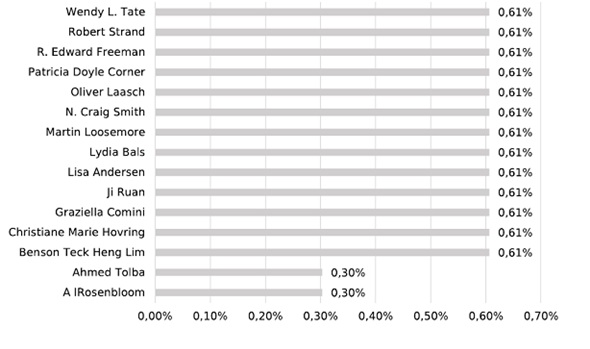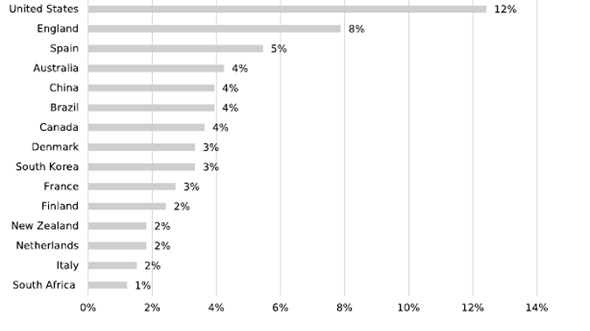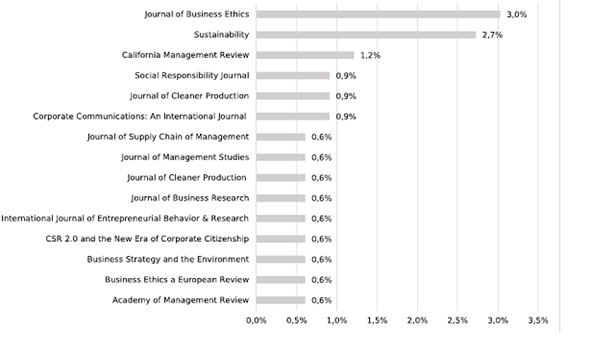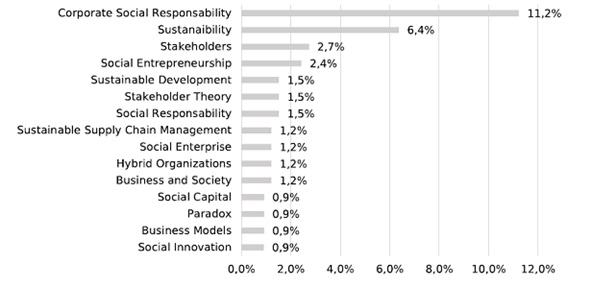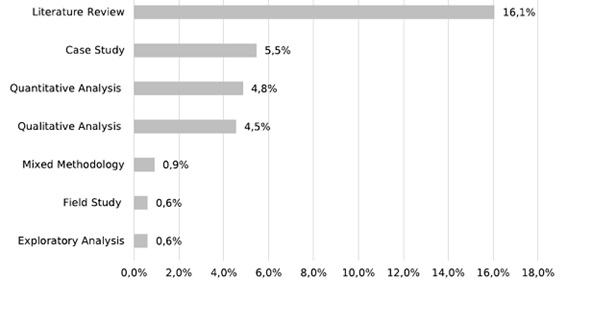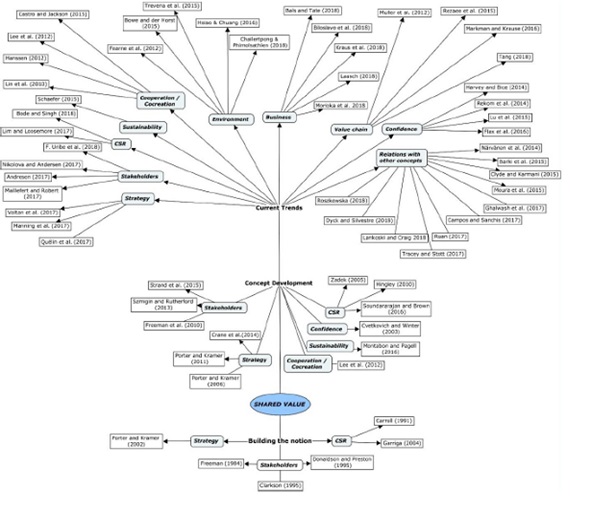1. Introduction
The academic literature of the last fifty years has generated an intense debate on the relationship between business and society, where interest groups are increasingly sensitive to business actions. For these reasons, companies have sought strategies to link their objectives with that of their stakeholders through the application of Corporate Social Responsibility (CSR) policies.
However, according to Muñoz (2013), many of these guidelines do not show a connection with the purpose and object of the business, generating conflicts of interest between CSR activities and the company’s objectives.
Given the ambivalence exposed above, the concept of shared value is born, being for some authors a strategy that generates a balance between the vision of competitiveness and profitability proposed by the capitalist system and the ethical duty of companies to give back to their environment part of the benefits that they obtain for the exercise of their activity (Méndez Pinzón and Gomez Osorio, 2017).
The SV is a recent theory whose literature shows little consensus in the development of its definition, since its origin relates it to three different approaches: stakeholder theory (Strand and Freeman, 2015), CSR (Crane, Palazzo, Spence, and Matten 2014) and strategy (Porter and Kramer, 2011); generating great terminological and conceptual confusion (Muñoz, 2013).
These approaches have been used in literature reviews to analyze the concept from a single perspective, for example: Laudal (2018) and Voltan, Hervieux, and Mills (2017) analyze the concept from the Porter and Kramer strategy approach, while Nielsen and Thomsen (2018) and Høvring (2017) carry out their analysis from the CSR perspective; and Uribe, Ortiz Marcos, and Uruburu (2018) are based on stakeholder theory.
Unlike previous research related to SV, this article aims to analyze the conceptual evolution of SV from the three approaches that originate it: strategy, corporate social responsibility (CSR) and stakeholder, which includes approaches, seminal authors, researchers who have developed the term and tendencies to current research, showing differences and similarities between study approaches; as well as a bibliometric analysis of the subject where prominent authors, journals with publication trends in the subject, countries that support their research, keywords and methodologies used to approach the concept are identified.
The analysis is carried out in order to answer the following research questions: what are the beginnings and current trends of shared value from the three approaches of origin of the concept? What are the conceptual differences between the research approaches of the SV?, Who are the seminal authors and authors with the highest number of publications in SV?, What are the main methodologies and keywords used, journals with publication trends on the subject and the countries that most support the development of research in shared value?
To answer the previous questions, the article has been organized in five parts: after this introduction, the theoretical framework of the concept of SV a priori to this research is presented; to then explain the methodology used in the systematic collection and analysis of information; whose findings are evidenced in the following section of results and discussion. Finally, the article ends with the conclusions of the investigation and comments on future investigations.
2. Theoretical framework
This section explains the concept and characteristics of shared value from a general perspective a priori to this research.
According to Porter and Kramer (2011) , the SV are policies and operating practices that improve the competitiveness of a company while simultaneously advancing the economic aspect and the social conditions in the communities in which it operates. For another group of authors, the concept of the SV is associated with stakeholders, among which is: value creation not only for shareholders, but for all stakeholders.
Finally, there is another group that links SV with the value chain (Fearne, Garcia Martinez, and Dent, 2012) and the environment (Dubois and Dubois, 2012); defining it as the simultaneous creation of economic value for the company, society and the environmental value of the places where business is done (Shrivastava and Kennelly, 2013).
Despite the differences of the authors named above, it is coincidental to define the SV as the integration of the generation of economic and social value (society and environment) by an organization, which generates positive impacts for all stakeholders. To achieve this, managers are required to align their strategies to implement programs that solve the problems and interests of stakeholders (Mühlbacher and Böbel, 2019).
According to Porter and Kramer, (2011) three ways creating SV are identified: reconceiving products and markets, redefining productivity in the value chain and developing local clusters”.
Recent research (Fernández-Gámez, Gutiérrez-Ruiz, Becerra-Vicario, and Ruiz-Palomo, 2019) have shown that the application of SV strategies generates greater financial performance in the companies that apply it; however, other findings affirm that the companies with thehighest financial performance are the ones that carry out the most SV activities, so successful companies are adopting this practice as a result of a management trendrather than a real contribution to the finances of the company (Jones and Wright, 2018).
3. Methodology
To conduct the literature review, the Graph Theory (Euler, 1741) adapted by Robledo Giraldo, Duque Méndez, and Zuluaga Giraldo (2013) was applied; which consists of identifying the relevant articles of a topic using the citation networks that establish the nodes of interest around it.
The classification indicators are given by the degree of entry, intermediation and exit of the citations of the articles, which results in what Robledo Giraldo et al. (2013) called the Tree of Science (ToS, for its use in English).
The Tree of Science is a tree figure where the roots are the articles that have high entry and zero exit degrees and correspond to the seminal authors (or main authors of conceptual origin). The articles that have a high degree of intermediation correspond to the trunk and are the authors who present the conceptual evolution of the topic. When the investigations have a medium-high degree of intermediation, they form the branches of the tree and represent the authors who show the approaches/perspectives of the main concept. Finally, the articles with a high degree of exit and zero entry are the sheets and correspond to the authors who adopt an established approach and their contribution according to the citations is still marginal.
Although there is still no clarity of the concept of knowledge networks (Liu, Jiang, and Ma, 2013) it is considered that the articles represent units of knowledge and are the so-called network nodes and the links (article references) indicate the connections between these articles (Robledo Giraldo et al., 2013).
Thus, considering the properties of the references found in the networks and their input and output indicators for each article, they could be classified into seminal (origin of the concept), development and trend.
For the construction of the ToS, the search for the articles in the Web of Science (WoS) database was first carried out, using the following TS parameters: (“SHARED VALUE”). PERIOD: 1990-2018. TYPE OF DOCUMENTS: ARTICLES. INDICES: SCI-EXPANDED, SSCI, A & HCI, ESCI.
The search results yielded 330 articles, which generated a network with the same number of nodes and 850 citations, highlighting 82 articles as the most cited in the topic.
The articles with the highest number of references were read in their entirety critically, allowing content analysis. For this, an Excel matrix was used with different columns that allowed registering: classification according to graph theory (root, trunk, branch and leaf), authors, journal, date of publication, country of origin of the research, keywords, methodology , managed concept, research topic, conclusions and relevant observations of the article.
The information organized in Excel allowed to generate statistics that are presented in the following section. Likewise, generate an analysis of the concept of shared value and its differences according to the three approaches that originate the concept.
4. Results and discussion
This section presents the findings of the systematic review of the literature based on the concept of SV. In the first part, an analysis of the main authors, words related to the term, countries and journals with the greatest research development in SV and the most used methodologies to address this topic are shown. In a second part, some academic discussions about the origin of the SV are addressed and finally it is explained how the conceptual development of the SV has been until reaching its current research trends, based on the three approaches that originate the concept.
4.1. Distribution of publications on shared value
Until 2018, 330 articles on SV have been published in WoS, identifying 234 authors who have developed the topic in their research, highlighting the intellectual production of Tate, Strand, Freeman, Doyle, Laasch, Craig, Loosemore, Bals, Andersen, Ruan, Comini, Hovring and Heng Lim, whose publications represent approximately 8% of the total number of documents that develop the theme (Graph 1).
By analyzing the affiliations of each author, it was determined that research on CV has been carried out mainly in countries such as the United States (12%), England (8%) and Spain (5%). Graph 2 shows the 15 countries with the highest intellectual production related to CV, which represent 60% of the total number of documents analyzed.
According to the analyzed works, the articles on CV have been published in 72 WoS-indexed journals, among which are: Journal of Business Ethics (3%), Sustainability (2.7%) and California Management Review (1.2%). Graph 3 shows the journals with the greatest number of articles published on CV, representing 15.2% of the documents studied.
Regarding the keywords, the authors’ keywords and indexed keywords were identified in the metadata, thus obtaining 366 words in the 330 documents studied. For analysis purposes, the Graph 4 shows the 15 most frequent keywords (after SV and SV creation), which are found in 35.7% of the records. The analysis highlights words such as: CSR, sustainability and stakeholders.
4.1.1. Methods used for research on shared value.
Research on SV has been characterized by having a strong conceptual component, which is evidenced by the fact that the main methodologies used to address the topic are literature review (16.1%) and case study (5.5%). Furthermore, in the analysis of the 330 records found in WoS, they were also found in lower proportions quantitative analysis (4.8%), qualitative analysis (4.5%), mixed studies (0.9%), field studies (0.6%) and exploratory analysis (0.6%), such and as shown in Graph 5.
4.2. Concept of shared value from the three approaches that originate it
The term SV has been explicitly exposed and popularized by Porter and Kramer in their articles of the year (2006) and (2011); However, it has generated controversy among academics about its originality, where critics affirm that SV has its origins with the theory of stakeholders (Strand and Freeman, 2015) and CSR (Crane et al., 2014), such as shown in Graph 6, in the section “construction of the concept”.
In order to understand the debate on the origin of the concept, a comparison of the approaches is presented below: strategy, CSR and stakeholders that build the concept of SV (Table 1).
Table 1 Comparative between the approaches that originate the concept of SV
| Analysis Factor | CSR | Stakeholder Theory | From the Strategy according to Porter and Kramer |
|---|---|---|---|
| Seminal authors of the concept | Davis (1973) , Johnson (1971), Wood (1991) , Carroll (1991) ); Garriga and Melé, (2004) | Freeman, (1984) , Clarkson, (1995) ; Donaldson and Preston, (1995) | Porter and Kramer, (2002) |
| Concept | Inclusion of CSR in the company’s strategy, in order to integrate economic and social value in its activities as an organization (Simon Zadek, 2005a). For Hingley (2010) CSR is not just doing good; it means that CSR must be part of the organization’s DNA | Stakeholders cannot be seen as competitors but as allies, where efforts must be focused on creating shared value (Strand and Freeman, 2015). Aims to put aside selfish thinking of single generation of business profitability (Freeman, Harrison, Wicks, Parmar, and De Colle, 2010). | He explains that the SV is an evolution of the CSR seen philanthropically. They try to explain that the strategic economic objectives of the company can be aligned with the social objectives. Likewise, they show in a practical way how to apply the concept. |
| Concept | Integration of economic and social value in company strategy (Simon Zadek, 2005a). | The central purpose of a company is to créate as much value as possible for its stakeholders, recognizing the intersection of these stakeholders with the objectives of the company and seeking the ultimate goal of creating value on a mutual basis (Strand and Freeman, 2015). | Creating economic value in a way that also creates value for society, addressing its needs and challenges (Porter and Kramer, 2006). |
Source: Own authorship based on literature review.
From the three perspectives of origin of the concept (Table 1), a controversy has been generated in the academic world regarding its originality. After the article by Porter and Kramer (2011) , the authors Crane et al. (2014) published an article criticizing Porter’s concept, stating that the concept is unoriginal, does not take into account the tensions inherent in responsible business activity, is naive about business compliance, and is based on a superficial conception of role of the company in society. However, its success and reception, they argue, has been due to the popularity of Porter in the professional public, who are unaware of the advances developed with research in previous years, mainly on issues related to CSR since the 1950s and the theory of parts interested since the 80s.
Crane et al. (2014) , affirm that Porter and Kramer “caricature” the CSR literature to satisfy their own ends; saying that it is the “Great Idea” (Porter and Kramer, 2011) of a totally innovative character. According to them, Porter and Kramer forget about the evolution of CSR, from where their incorporation into the company’s strategy for the generation of competitive advantage has been promoted; they also fail to recognize that their ideas about the simultaneous creation of economic and social value for multiple stakeholders have already been developed in the existing literature.
These criticisms were refuted by Porter and Kramer (2014) stating that substantial changes in the behavior of companies around the world have occurred as a result of their article.
On the other hand, Strand and Freeman (2015) affirm that the theory and practice of interest groups are inexplicably similar to the concept of CV proposed in the Harvard Business Review article by Porter and Kramer (2011) “Creating Shared Value”. According to Strand and Freeman (2015), the theory of stakeholders shows from its beginnings that the company and its stakeholders have common (shared) interests, likewise; in practice, companies are concerned with seeking to integrate economic value with social value (represented by stakeholders).
Although the concept of SV became popular with the publication of Porter and Kramer, the evolution of CSR from a philanthropic approach towards incorporating win-win into the strategic core of the company should not be ignored.
Likewise, the central philosophy of stakeholder theory, which focuses on sharing the benefits with all stakeholders, should not be forgotten. Following Crane et al. (2014) it is stated that Porter and Kramer given their practical approach has made the term quickly recognized and adopted in the business field, however, it was not entirely their invention. Similarly, the extension of the concept given by Porter and Kramer is highlighted, who shows in a pragmatic and applied way the shared value.
Despite the controversy over the origin of the concept, it has been possible to establish common characteristics of CV identified in the literature review: a). The existence of mutual value as a fundamental element, b). Integration of the generation of economic and social value (environment and society), c). It is based on collaborative work, d). They generate positive impacts to stakeholders, e). They are linked to the stakeholders, regardless of stratification, level of education, economic situation, etc., f). They are the results of the implementation of integration strategies for the generation of economic and social value.
4.2.1. Development and current trends of the concept of shared value from the three approaches that originate it.
In the development of the term or trunk (see middle part of Graph 6) the approaches are maintained: the strategy continuously worked by Porter and Kramer (2011, 2006), the CSR approach where authors such as Zadek (2005b) stand out; Hingley (2010) ; Zheng, Luo, and Maksimov (2015) and Soundararajan and Brown (2016) and the stakeholder theory-based approach with authors such as Freeman et al. (2010) , Szmigin and Rutherford (2013) and Strand, Freeman,and Hockerts (2015) . However, other research perspectives emerged that, although with less force, are relevant to see future study trends such as sustainability (Montabon, Pagell, and Wu, 2016), SV as a basis for measuring confidence (Cvetkovich and Winter, 2003) and the SV from a perspective of cooperation and co-creation (Lee, Olson, and Trimi, 2012).
In current trends of the concept, it is shown in the upper part of graph 6, there are publications in relation to the three initial approaches worked: strategy (Porter and Kramer, 2011) such as those carried out by Voltan et al. (2017) , who make an analysis of the concept of SV creation. Likewise, there are authors such as: Loosemore and Lim (2018) , Bode and Singh (2018) and Lim and Loosemore (2017) who have recently developed the concept of SV from the perspective of CSR. Likewise, current studies are presented based on the creation of SV from the point of view of the theory of stakeholders (Andersen, 2017; Maillefert and Robert, 2017; Nikolova and Andersen, 2017; Uribe et al., 2018).
As in the development of the concept, in the current trends, works associated with sustainability are evident (Schaefer, Corner, and Kearins, 2015), the SV as an influential variable in the relationship of trust with different levels: community (Wu and Tsang, 2008), clients (Law, 2008; Van Rekom, Go, and Calter, 2014), society (Harvey and Bice, 2014; Lu, Xie, and Xiong, 2015), and suppliers (Flax, Bick, and Abratt, 2016) and defines how the SV has been developed in the strategies of Cooperation (Hanssen, 2012; Lin, Wang, Tsai, and Hsu, 2010) and Co-creation (Castro-Martinez and Jackson, 2015; Lee et al., 2012).
In recent articles (the leaves of the tree), studies were found where SV is analyzed from an environmental perspective (Chailertpong and Phimolsathien, 2018); Bowe and van der Horst, 2015; Fearne et al., 2012; Hsiao and Chuang, 2016; Trevena, Kaldor, and Downs, 2015), in the field of business (Biloslavo, Bagnoli, and Edgar, 2018; Kraus, Burtscher, Vallaster, and Angerer, 2018; Laasch, 2018; Morioka, Bolis, and de Carvalho, 2018; Tate and Bals, 2018) and in relation to the company’s value chain (Tang, 2018; Rezaee, 2018; Berning and Venter, 2015; Markman and Krause, 2016; Muller, Vermeulen, and Glasbergen, 2012).
As well as studies of the relationship of the SV with other concepts such as: social entrepreneurship and social business (Campos-Climent and Sanchis-Palacio, 2017; Ghalwash et al., 2017; Barki, Comini, Cunliffe, Hart, and Rai, 2015; Moura, Comini, and Teodósio, 2015), economic theory (Clyde and Karnani, 2015), social welfare (Lankoski and Smith, 2018), social capital (Ruan, 2017; Yang and Farn, 2009), open innovation (Roszkowska-Menkes, 2018), sustainable innovation (Dyck and Silvestre, 2018), social innovation (Stott and Tracey, 2018) and collective consumption (Närvänen, Gummesson, and Kuusela, 2014).
The development of the concept of shared value from the seminal works shows a strong tendency to continue with one of the three initial approaches: strategy, CSR or stakeholders. However, new research related to cooperation and co-creation that includes entrepreneurship is beginning to show signs of interest among researchers.
The Anglo-Saxon domain of academic literature on the subject of SV is not surprising since it is precisely in this country where the most related and prestigious seminal authors and specialized magazines appear.
It is also pertinent to emphasize that due to the relatively new concept, a first theoretical approach is hardly being made, where literature reviews and case studies predominate. The thematic meetings of the SV following the count of keywords of the concepts of social responsibility and stakeholders as predominant. It is possible that the new research directions will take the concept of shared value to empirical and experimental works as it has been developed with other concepts (eg: CSR).
5. Conclusions
At the end of the investigation, it can be concluded that the origin of the SV is diffuse, taking into account the different perspectives that have been used to explain its birth: stakeholder theory led by Freeman, CSR postulated by Zadeck and evolution of the strategy by Porter and Kramer.
The most used concept to define SV is the one put forth by Porter and Kramer, who have been criticized for their lack of originality and the little recognition they perceive for the advances developed previously on the subject, showing an opportunistic side and taking advantage of their popularity to help to their personal interests.
However, there is a consensus of the characteristics (see table 1) that define SV within which there is the existence of Mutual Value as a fundamental requirement, the need for collaborative work for the integration of the generation of economic and social value, and generating positive impacts to stakeholders.
Likewise, currently, in addition to the three research approaches related to the origin of SV, there are works developed under the perspective of sustainability, SV as a variable to measure trust, SV from a cooperation and co-creation perspective, the SV from the perspective of the environment, in the field of business, in relation to the value chain of the company and the SV related to other concepts such as: social entrepreneurship and social business, economic theory, social welfare, capital, open innovation, sustainable innovation, social innovation and collective consumption.
Additionally, in the bibliometric analysis, the Journal of Business Ethics, Sustainability and California Management Review were identified as the journals with the highest publication trend about shared value, with countries such as the United States, England and Spain as the ones that carry out the most research on the subject, as well such as CSR, sustainability and stakeholders turned out to be the most related keywords by the authors when talking about SV.
Similarly, it was possible to identify a strong conceptual component for the development of SV research methodologies, evidencing that the most used method to address the subject has been the literature review, so the absence of empirical works that demonstrate their operationalization, as well as the measurement of the impacts generated by the application of the strategies in the organizations and in the community.
Through the evolution of the SV concept, it is concluded that the three main study approaches are still preserved: strategy, CSR and stakeholders. However, from this review, considerations can be made regarding future research related to the opening of new study approaches such as shared value used as a tool for cooperation, co-creation and entrepreneurship. The importance of conducting studies using empirical and experimental data is also established to explain the application of the concept.














